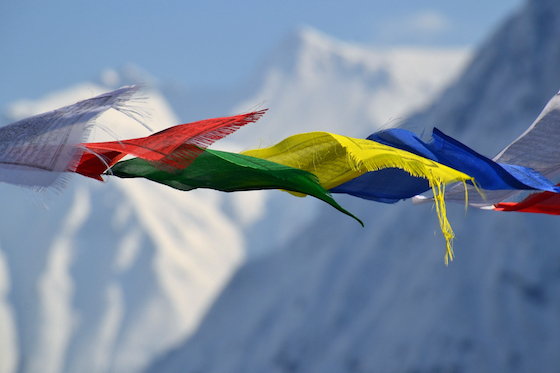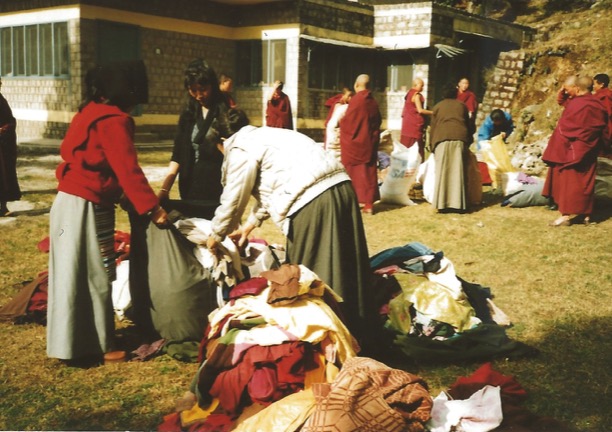This is the story of a Tibetan Buddhist nun living in exile in India. In August 2018 she is taking her final set of examinations for the Geshema degree. This highest degree, equivalent to a PhD in Tibetan Buddhism, was until very recently only open to men. To protect this nun’s privacy and the safety of her family still in Tibet, we have not used her name or the some of the details of her home.
I was born in 1968 in a village in eastern Tibet situated on the hillside of a thickly wooded valley. Above our village was our pastureland and further north there are rocky mountains. There were about 25 semi-nomadic families living in our village when I lived there.

Traditional Tibetan prayer flags flutter in front of snow mountains.
Our winters are very cold, like all the other places in Tibet, but the summer temperatures are quite high. Crops like corn, peas, and wheat grow very well there. Our herd consisted of only yaks and dris (female yaks). We didn’t live on the mountains permanently like the nomads.
During the summer months, we stayed in small yak hair tents called masong pitched on the higher grasslands and, in the winter, we returned to the farm. All the village animals were tended by one designated person during the winter when there wasn’t much work to do. In summer, during the calving season, all the animal owners returned to the mountains and pitched their tents, where they remained for the entire summer.
My parents and three of my brothers still live at our home in Tibet. I am the only daughter. My youngest brother is a monk studying in a monastery in South India. I never went to school in Tibet. I spent my time at home tending the animals. There was work in the village, but I always chose to be up on the mountains with the animals.

Nun’s bag and robe. Photo courtesy of Olivier Adam
At age 18, I became a nun. In 1989, I joined a group of pilgrims from Lithang who were doing a prostration pilgrimage from Lithang to Lhasa to see the holy temple called the Jokhang.
[Note: A prostration pilgrimage is a form a Tibetan Buddhist worship in which the person stretches out full length on the ground, marks the spot where her or his fingertips reach, and stands and steps forward to that spot, then prostrates again. Through prostrations, Tibetan Buddhists seek to purify the body, speech, and mind, freeing oneself from delusions, negativity, and any bad karma. It is a form of spiritual devotion and mental training that, like other forms of Buddhist practice, was banned by the Chinese during the Cultural Revolution. The large group of over 150 Tibetan Buddhist nuns and monks who undertook this pilgrimage from Lithang to Lhasa performed prostrations for the entire distance – about 1,200-miles. Here’s a short video showing a Tibetan Buddhist nun and a lay person prostrating in Lhasa.]
Lithang is about two days by car from my home. I was with the group from the very beginning of the pilgrimage. We gathered at Lithang and then prostrated eastward to Menyak to see the famous Pai-lhakhang, the temple dedicated to Palden Lhamo, the guardian deity of Tibet.
We returned to Lithang after six months and then made our journey towards Lhasa. The pilgrimage took us almost two years to complete. On the way, I learned to read and write Tibetan. We prostrated during the day and in the evenings we studied by the light of oil lamps and candles. It was a hard pilgrimage. We couldn’t do the whole distance from Lithang to Lhasa by prostrations because the group became too large after a time and it was impossible for such a large group to keep moving. So we would stop at a few places for months, do a number of prostrations, and then move again until we reached Lhasa.

This nun was one of this large group of pilgrims from Lithang who did prostrations for over two years. When they escaped from Tibet and arrived in India, there was no space at existing nunneries to accommodate them. The Tibetan Nuns Project cared for them and other nuns and eventually built two new nunneries, Dolma Ling and Shugsep.
At Lhasa, we could not enter the holy city because there was trouble in the Tibetan capital at the time and the Chinese were fearful of the attention such a large group might attract. We were instead diverted to southern Tibet to another holy city, Shigatse. From Shigatse, we went on pilgrimage to Mount Kailash and Lake Manasarovar. At Kailash, Yonton Phuntsok Rinpoche [a lama from Kham and the leader of the pilgrimage] decided to leave for India, and I, along with many other monks and nuns, followed him into exile. He made all the arrangements for our escape and we didn’t have to do much. We came to Dharamsala via Nepal and have remained in Dharamsala ever since.
[A note about the escape from Tibet: Like most Tibetans, this group escaped on foot over the Himalayas to Nepal. It took the group 27 or 28 days to make this harrowing journey into exile. The group was ill equipped and was forced to hide during the day and walk at night in order to avoid detection. Once in Nepal, they went to the Tibetan Reception Center at Kathmandu for medical care and to register as refugees. Now the border is heavily patrolled and freedom of movement inside Tibet is severely restricted, so it is virtually impossible for Tibetans to escape.]
The Tibetan Nuns Project took care of us from the very beginning. I saw Dolma Ling Nunnery come alive from barren land into becoming this popular center of learning where people flock to get a place. All the nuns who were with me on the pilgrimage are also at Dolma Ling. The study course here is for 19 years and I have now completed all 19 years of Buddhist philosophical studies.

Four nuns and a small tent on the empty plot of land where Dolma Ling Nunnery was built. The nunnery is now home to about 250 nuns.
At Dolma Ling we have a computer room. Nuns who received training from overseas volunteers with support from the Tibetan Nuns Project then taught us and there are many nuns who are interested in learning. I have learned basic computer skills for many years now and I feel so proud.

Computer training for Tibetan nuns by volunteer, Harald Weichhart, 2009.
I feel so privileged to be a part of this institute, and I am thankful to everyone who made this possible for us. I am happy here, and Dolma Ling will be my home for many years to come.






